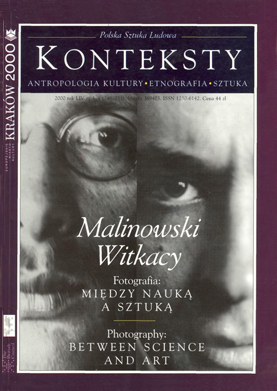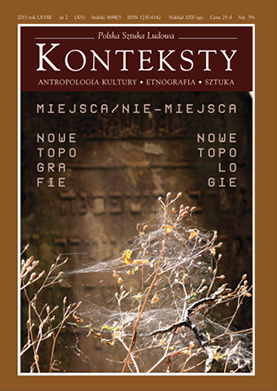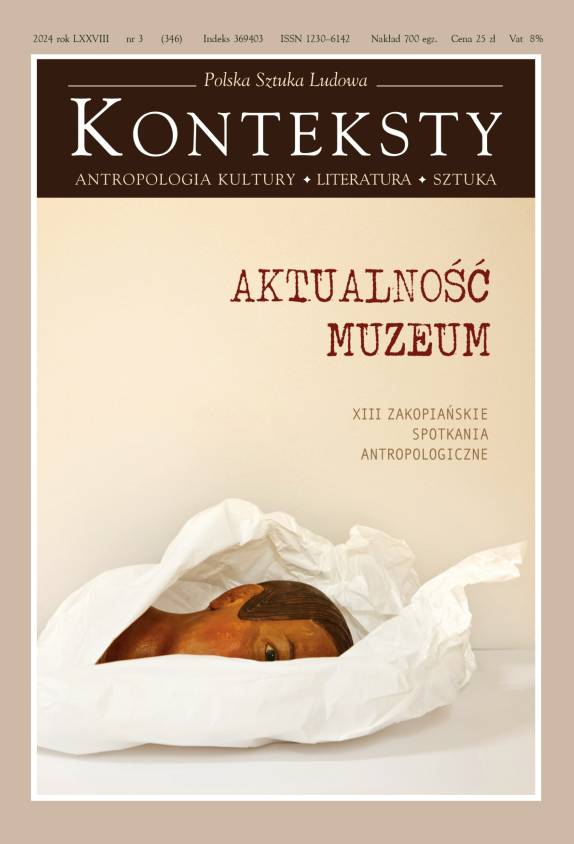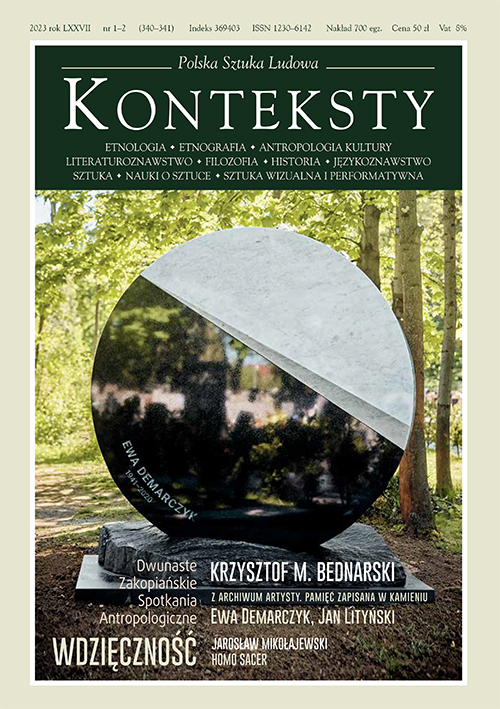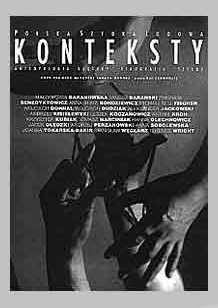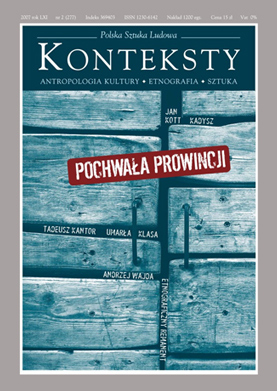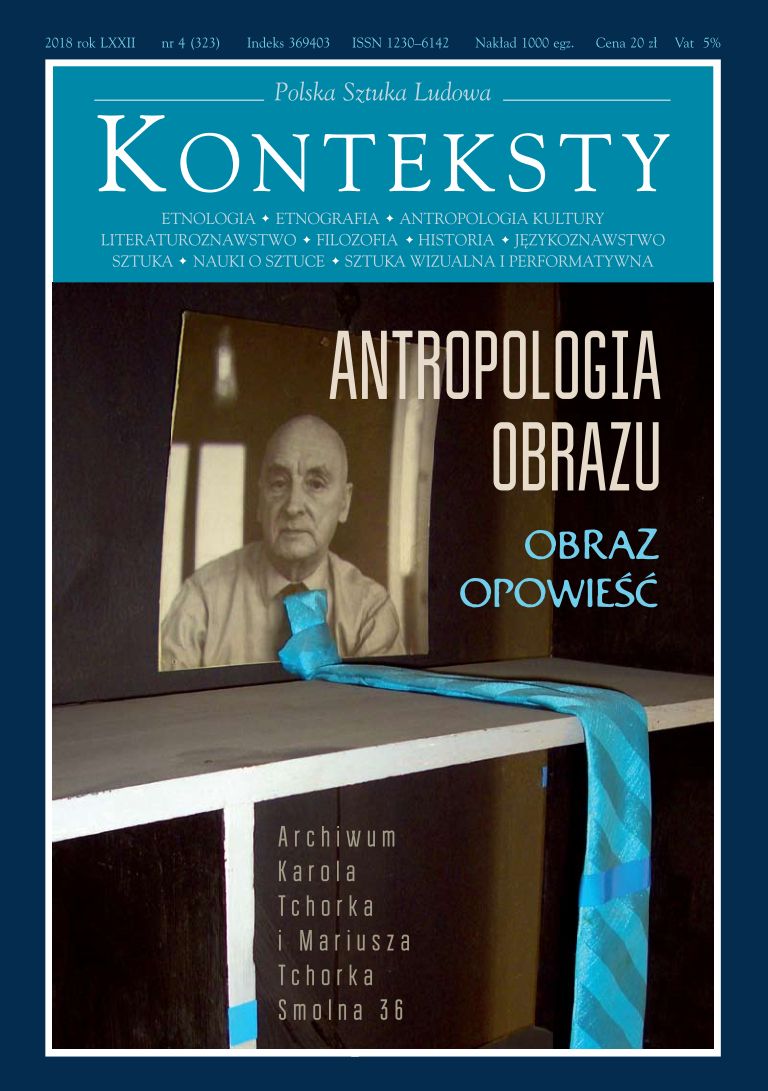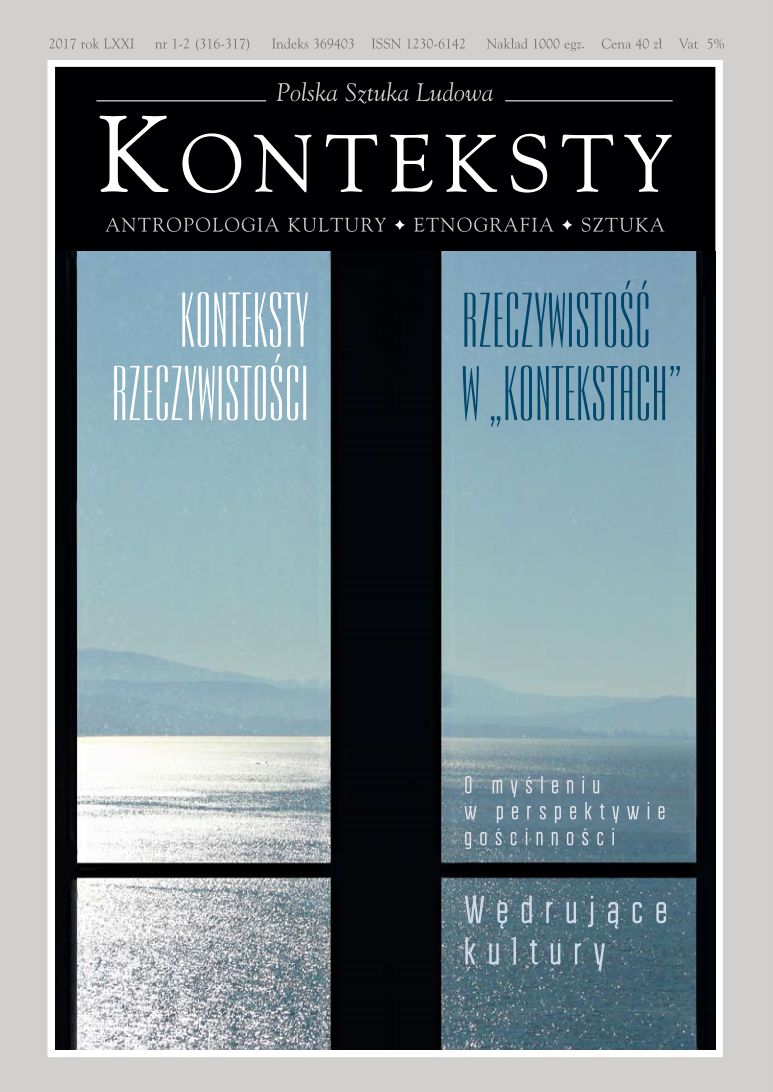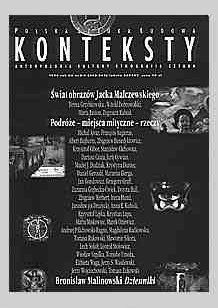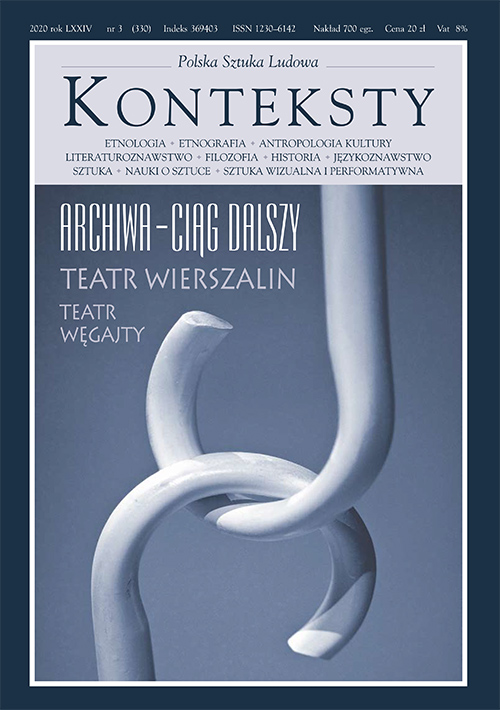Issue 2014/2 (305) - Circles of Art

| Ryszard Kasperowicz | Warning against the Illusion of Absolute Clarity, the Perception Trap of Schemes. On the Works of Prof. Maria Poprzęcka – Laudation  | 6 |
Professor Maria Poprzęcka is one of the best-recognised and outstanding historians of art in Poland. An excellent teacher, she specialises in the history of art and its theories in the eighteenth and the nineteenth century, at the same time expanding a highly acclaimed art critique. Prof. Poprzęcka is also an extremely rare example of a combination of immense erudition and familiarity with the art of the past epochs with an extraordinary and empathetic ability to discuss contemporary art. Her writings, with their characteristic diverse presentations, brilliant arguments, profound opinions, and apt selection of concepts, are both exceptional and wideranging. In her texts Prof. Poprzęcka not only brings the reader closer to the most complex art phenomena, which is she interprets in a truly masterful way, but she also discusses phenomena to which we are still incapable of granting suitable definitions; at the same time, she incessantly appeals for a democratization of our perception petrified by assorted schemes of the history of art and critical rhetoric, and warns against the traps of perception threatening both historians of art and their readers. Essays by Maria Poprzęcka, together with their accomplished form and adroit popularisation of difficult problems, make an unwavering appeal for developing the skill of perceiving and absorbing art phenomena while remaining aware of all the dangers associated with the domination of a superficially experienced visual culture and a sui generis pan-aestheticization of the world. Her essays are an unattainable model for emulating an aptitude for perception, an interpretation that always does justice to a work of art, and a translation of the image into the word; they also pose a genuine intellectual challenge. | ||
| Luiza Nader | Creation of the Female Subject  | 9 |
Laudation given upon the occasion of presenting Professor Maria Poprzęcka with the Ksawery and Mieczysław Pruszyński PEN Club Award (30 June 2014). The author followed the feminist motifs in Maria Poprzęcka’s oeuvre and interpreted her selected books in the spirit of Hélène Cixous: “Woman must put herself into the text - as into the world and into history - by her own movement”. | ||
| Maria Poprzęcka | What Is the Purpose of Art?  | 11 |
Apparently, the question: what is the purpose of art? is not only a sign of uncertainty on the part of doubtful historians of art. It seems to be also characteristic for one of the stands emerging in contemporary art. This by no means new attitude is becoming conspicuously more intense in recent years, beginning with several extremely diverse artistic undertakings disbelieving the undisputed status of art… The text is a survey of art works and stances pertaining to this problem. | ||
| Zbigniew Benedyktowicz | Circles of Art  | |
The growth of the European Union, media globalization and commercialization indicate an urgent need to create a place, which will exhibit the current works of young European and international artists. New trends and movements in the arts and confronting them with Masters and the public – all this takes place in one space and time at the Circles of Art Festival. Fields of artistic activities are evolving in an unprecedented speed in the history of art due to the development of media techniques. These „circles of art” provide a way to showcase achievements from various fields of art: music, theatre, film, visual arts, among them new media and other interdisciplinary works. The ability to draw from the heritage of past generations, as well as being open towards the latest trends and technology, was what brought together a lecture and recital by the renowned pianist and teacher Andrzej Jasiński and „Video-Well” - a multimedia event by students from the new media department headed by Marian Oslislo of the Academy of Fine Arts in Katowice. European art academies hold huge potential that could benefit societies. One of the key features of the Circles of Art festival is bringing together art and scholars, which is why each year we also invite experts in fields connected with the arts, such as anthropology, ethnography, history of art, philosophy and others. Educating society in art and culture, regardless of age, environment, level and type of education or economic status, is another aim of the festival. Through this, we reduce the group of those excluded from culture, and in later stages, from society. We cater to have the broadest range through free access to festival events and their diversity. During each edition, dozens of concerts take place, over 100 films are played and numerous workshops, lectures and other events are carried out. The 5 edition of the Circles of Art festival, which took place alongside the film festival Wakacyjne Kadry, confirmed the need to meet on the part of European academic environments, inhabitants of cities and regions that welcomed the festival, but also on the part of tourists, who all the more often search not only for scenic views, but an experience with the highest quality of culture and art. The first place to undertake the idea of the festival was Cieszyn. What encouraged this was its openness towards religion and multi-culture character, traditions connected with education, but also its location – on the former boarder on the Olza river – between Poland and the Czech Republic. We continuously expand the festival’s circles of art to other centers in the country and the world. The Festival of European Art Academies and Art, Circles of Art, provides conditions for promoting the region and its universities and art academies – hosts of the festival. Through this, we also promote Polish culture, art and artistic education in other countries. | ||
| Zbigniew Benedyktowicz | On Circles of Art – a Conversation with Wojciech Majewski | 18 |
| * | Circles of Art – a Chronicle | 25 |
| Andrzej Jasiński, Zbigniew Benedyktowicz | Master and Student | 42 |
| Ludwik Stomma | Anthropology of War | 52 |
| Ludwik Stomma | Farewell to Paris | 58 |
| Małgorzata Sady | Semantic Poetry of Stefan Themerson | 62 |
| Stefan Themerson | Letter to Kazimierz Askanas | 68 |
| Małgorzata Sady | Franciszka and Stefan Themerson – Lives | 71 |
| Stefan Themerson | Aphorisms | 77 |
| Stefan Themerson | Poems | 78 |
| Stefan Themerson | O, God! | 80 |
| * | Films Made by Franciszka and Stefan Themerson | 82 |
| Małgorzata Sady | Czechowicz Translated | 83 |
| Józef Czechowicz | Light in the Afternoon | 84 |
| Józef Czechowicz | Światło południa | 84 |
| Bogusława Sochańska | The Oeuvre of Hans Christian Andersen and His Visual Arts Works | 87 |
| Bogusława Sochańska | Image of Hans Christian Andersen and the Truth of His Diaries | 92 |
| Hans Christian Andersen | Diaries Fragments | 100 |
| Iwona Chmielewska | Picturebook – a Book for Readers of All Ages | 109 |
| Andrzej Mitan | Interview with Myself | 116 |
| Kazimierz Piotrowski | Andrzej Mitan – A Job-like Experience | 120 |
| Eulalia Domanowska | Life is Art | 122 |
| Witold Chmielewski | To Cieszyn with „Akcja Podróż” | 130 |
| Witold Chmielewski | Is It Possible for Cieszyn to Be in the Centre of the World? | 138 |
| Mikołaj Góralik | Kurt Weber – A Portrait of a Creator | 143 |
| Leszek Kołakowski | Letter to Kurt Weber | 148 |
| Leszek Kołakowski | Rzeczy [Things] Ideas for an Animated Film against Things | 151 |
| Marian Oslislo | Letter and Sign | 153 |
| Eulalia Domanowska | From a Monument to Pastry | 165 |
| Eulalia Domanowska | With a Head in Clouds | 172 |
| Piotr Matywiecki | Henry Moore – initiation | 176 |
| Anna Krysztofiak | Circles of Art. Exotic Journey via Quanzhou to Cieszyn | 179 |
| Marek Tylkowski, Wang Yun | Chinese Calligraphy | 184 |
| Marek Tylkowski | Self-improvement in Confucianism | 185 |
| Wang Yun | A Look at a Chinese Face. Psychological Motifs and Social Representations | 194 |
| * | Schools of Higher Learning Participating in the Circles of Art Festival | 197 |
| Maria Pomianowska | Global Identity and Enrootment in Tradition | 200 |
| Eduard Ovčaček | Arguments Fragments | 207 |
| Eduard Ovčaček | A Short Lecture on Experimental Poetry | 214 |
| Zbigniew Bajek | Kafka – Taming the Alien | 217 |
| Adriana Zimnowoda | De Profundis: Mystery of the Body. Mystery of the Mind. Procession of Defining Identity | 222 |
| Przemysław Piotrowski | Hospes, hostis | 224 |
| Stanisław Wieczorek | Sincere Lies | 227 |
| Janusz Fogler | Art of the Media at the Academy of Fine Arts in Warsaw | 231 |
| Jan Dąbkowski | A Man without Barriers | 234 |
| Ireneusz Betlewicz | To Grażyna in a Birthday Bouquet | 236 |
| Tomasz Przybyszewski | Ireneusz Betlewicz – Poet and Painter | 237 |
| Piotr Pawłowski | Last Letter to Irek Betlewicz | 239 |
| Ernest Bryll | Fragments of Introductions to Volumes of Poetry by Ireneusz Betlewicz | 239 |
| Wojciech Majewski | Graphic Art in Circles of Art | 241 |
| Sebastian Kubica, Wojciech Majewski | Freedom on B1 | 244 |
| Wacław Tkaczuk | Once a Poet, Always a Poet | 247 |
| Paweł Targiel | O tyle więcej. Poems | 249 |
| Anna Kozińska-Targiel | Life and Works of Paweł Targiel | 250 |
| Krzysztof Siwczyk, Maciej Melecki | History of the Mikołowski Institute | 253 |
| Magdalena Fabiś | Interrupted Silence and Changed Tone. Reflections on the Contemporary Prose of Upper Silesia | 255 |
| Piotr Piotrowski | East European Artistic Peripheries and the Post-colonial Theory  | 262 |
„The emergent form of contemporary history of art studies is the result of globalization. Naturally, the question whether their solution is convincing, or not, constitutes a separate issue. Apparently, the history of art is endeavouring to tackle this problem and in doing so it resorts to, i.a. post-colonial studies. Although their sources and fundamental domain of research are situated in strictly historical, literary, philosophical and social science studies this type of research pursued by the history of art seems to be effective, as evidenced predominantly by a whole complex of history of art studies associated with a revision of modernism, its decentralisation, pluralisation, and a new geography of art” – Piotrowski claims. His text attempts to take a look at the art of Central-Eastern Europe within the context of the post-colonial theory and, first and foremost, the geography of art. | ||
| Wiesław Juszczak | Music and Eliot  | 273 |
Biographies and commentaries dealing with the works of T. S. Eliot frequently mention Beethoven’s Quartet in A minor, Op. 132, whose recording he purchased probably in 1931 as evidenced by a letter to Stephen Spender (28 March) in which the poet wrote that a record of the Quartet in A minor is an inexhaustible source of reflections. He had in mind indubitably the earliest recording (1924) of this composition, made in London in 1924 by the Hungarian Léner Quartet for Columbia Records. This is certainly the same version described four years later by Aldous Huxley in Point Counter Point, which returns upon several occasions to the motif of the Molto dagio, the middle part of the quartet (the third of five): Heiliger Dankgesang eines Ge-nesenen an die Gottheit, in der lydischer Tonart(A Convalescent’s Holy Song of Thanksgiving to the Divinity, in the Lydian Mode). Theoretical-critical texts by Eliot note that the musical nature of poetry is exteriorised the most in those cases when the word is not linked directly with the musical structure. This view permits us to assume that according to the poet the same might be true also for songs. Such relations would, therefore, take place on more isolated and “abstract“ levels of the two plays, which always retained some sort of independence; in the domain of the word this would pertain in particular to drama. Starting with the pageant play: The Rock(1934) and all the way to contemporary plays – not to mention the famous Four Quartets – the problem of music always constituted the axis of the poet’s and playwright’s creative reflections. Not until 1953, however, did music make an appearance in the play: The Confidential Clerkas the “object of vocation“, the selection of the life path. According to Irena Sławińska, an eminent expert on religious or, to cite Eliot, “liturgical“ drama, this particular play delves into the problem of “make-believe, the fictional, false world in which we live once we consent to the imposition of some sort of an alien life distant from our predilections. Sir Claude, the great financier, also describes the business world as make-believe! The door to genuine life leads through a gate of his personal passion: pottery. […] The young protagonist Colby, ‘his confidential clerk‘ […] dreams about the profession of an organist. This is his secret world and secret garden. Is existence in two such different worlds not a lie? Does it not give rise to an ominous cleft in life? […] In the play this question is carefully and comprehensively examined. Already the first dialogues disclose a solution. No, we do not have a right to divide life in this manner; as a work of art it must comprise an integral whole. Such a unification of life can be performed, however, only by geniuses – or saints“. In this play music is, therefore, elevated to a supreme rank as an object of vocation. | ||
| Krzysztof Lipka | Beethoven. Problems of Musical Ethics upon the Example of Philosophers’ Statements  | 285 |
Beethoven is without doubt a composer who appears most frequently in reflections by intellectuals discussing art. Apparently, the reason for this interest is the fact that a conspicuously characteristic feature of the oeuvre of this last classic is ethics. Upon the basis of selected fragments of statements made by W. Gombrowicz, K.R. Popper, R. Rolland, E. Delacroix, L. Tolstoy, T. Mann, M. Kundera, and R. M. Rilke it is possible to demonstrate that each of these thinkers discovered in Beethoven’s music slightly different ethical aspects. The powerful impact of Beethoven, which continues to produce the strongest emotions among his recipients, compels to seek in the compositions by the master of Bonn concrete traces of his involvement in ethics. The compelling expression of Beethoven’s music inspired among various authors either extreme adoration (Rolland, Mann, Rilke, Gombrowicz) and subtle irony (Kundera), or protest and ethical charges addressed to the author of Eroica (Tolstoy, Popper). | ||


































